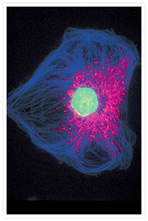Search Thermo Fisher Scientific
African clawed frog (Xenopus laevis) embryo stained with Vybrant® Cell Lineage Tracing Kit.
Embryos at the 8-cell stage were injected with anionic, lysine-fixable Cascade Blue® 10,000 MW dextran in one dorsal-animal blastomere and allowed to develop to various stages before being fixed. The Cascade Blue® dye, which serves as an antigen in this technique, was detected with an antibody to the Cascade Blue® dye and subsequently visualized with a secondary antibody conjugated to the Alexa Fluor® 546 dye (Cat. No. A11010). This photographic image was taken using a bandpass filter set appropriate for rhodamine. The image was contributed by Paul Wilson, Cornell University Medical College, New York, and Greg Cox, Molecular Probes, Inc.

Related Products
Related Images
A prometaphase muntjac skin fibroblast stained with Alexa Fluor® 350 phalloidin, an anti–a-tubulin antibody and an anti–cdc6 peptide antibody. Go ›

Bovine pulmonary artery endothelial cells (BPAEC). MitoTracker® Red CMXRos, SYTOX® Green nucleic acid stain, biotin-XX goat anti–mouse IgG antibody and Cascade Blue® NeutrAvidin biotin-binding protein. Go ›

Dual-emission ratiometric measurement of lysosomal pH using LysoSensor™ Yellow/Blue dextran. Go ›

Rhizoid cells from the marine alga Fucus serratus were pressure-microinjected with 10,000 MW Calcium Green™-1 dextran and 10,000 MW Texas Red® dextran. Go ›

Cyanobacteria. BODIPY® FL, DAPI and CellTracker™ Green BODIPY®. Go ›

Brain of a zebrafish embryo. CellTracker CM-DiI. Go ›

Live cell imaging with CellLight™ reagents. Go ›

Live cells transduced with Organelle Lights™ or Cellular Lights™ reagents. Go ›

CD335 (NKp46) Antibody (63335182) in RE Go ›

CD223 (LAG-3) Antibody (56223942) in TM Go ›

Mouse Anti-Alpha Tubulin Monoclonal Antibody (Cat. No. A11126) Go ›

Muntjac fibroblast labeled with probes for actin and the nucleus. Go ›
